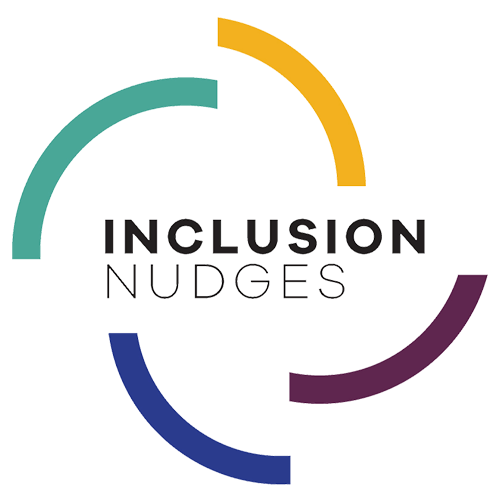Listen to this quick introduction by Tinna:
It’s quite common that men (especially white heterosexual Western men) are portrayed as the villains of inequality. It’s equally common to blame and shame them for this reality. This one-sided perception overshadows the fact that many men also want change in gender stereotypical norms that dominate many workplaces.
The problem is that these change-aspiring men also maintain the norms that they dislike and that harm them. They have not learned how not to maintain and perpetuate these norms and how not to play along. They have not been given opportunities to practice how to change the norms. It’s time to give them a safe space to practice and make this a bigger part of efforts for achieving healthy and inclusive workplaces.
Saturday morning as I was enjoying my coffee and morning newspaper, an article with the headline ‘Enjoy Your Paternity Leave – See You on Monday’ caught my attention. It was written by a man (Anders Haahr Rasmussen) who posed the question “What leads a man to perpetuate, in his right mind, the norms and ways of thinking, to which he himself has been subject and harmed by?”
I have been wondering about this as well due to several conversations I have had with male leaders in organisations and more recent conversations I have had with a male friend. In this article, I share some behavioural insights about the reasons for this and I share some suggestions for how to make the needed changes for the greater good of all.
A couple of real-life examples
The newspaper article I read is about a man who is taking paternity leave for 3 months. At his informal farewell gathering at work on his last workplace day, his boss gave a short, informal speech. The dominating masculine norms of this also dominated what the boss said and did not say. With a bit of laughter, he said “You will now have to change diapers and sing baby songs, which are not your prime competencies” and wishing him a great leave of absence, the boss finalised by saying “enjoy your parental leave – see you on Monday”. Meaning that he would have had enough of the baby after a few days and prefer to work instead.
The boss approached him afterwards to tell him “I am really happy for you. The only thing I really regret in my life is not having spent more time with my children when they were small”. So, why did he say as he did?
Reading this example reminded me about a conversation I had with my long-time friend a few weeks ago.
His was mentally in a bad state. Stressed. Working 80-100 hours a week. Not present with his children and wife. Having nightmares about drowning. His strategy was to continue on the path he was on, adding speed and more hours, and not divert an inch in order to achieve his goals. He could do this a few more years (his is only in his early 40’s). Meanwhile, his close friends and his wife see it differently. We see him more like the Titanic heading straight for the iceberg to crash and drown while we scream at him with love “divert, divert”.
I asked him, “Don’t you have one trusted colleague in your peer group of executive partners that you can talk to about this to change the work load”. With agitation he answered me, “Tinna, you of all people know how the culture is at executive level! You do not show a sign of weakness! If you do, you are doomed. It’s the same as suicide!”.
He was right. His first comment was not news to me. Having worked with groups of executive leaders for 14 years, I know how damaging the dominant masculinity norms are.
What really surprised me was his reply to my second question. When I reminded him about a partner colleague that he always talked about as being “a good friend and really good guy”. He said, “No way. We do NOT talk about such issues. It’s not an option!”. He was not even able to have an honest conversation with another man at work about something that is highly relevant and critical for both of them and to the company.
Shouldn’t it be of high concern for the partners to change these norms, given that such a culture can impact their own health and their employees, as well as the performance of the company?
My friend actually did make an effort to change the norms once before when he had just become partner. He took 3 months parental leave with his first-born son. This is in Denmark, where approximately 10% of men take a long parental leave. In the sector where he works, no one does that. But he wanted to and his wife insisted because she also had her career to attend to. Some years back, we talked about that and he said, “Don’t talk about that. I am still traumatised about that”. He didn’t mean because of his child because that was for him great joy (and hard work). He shared with me that his partner colleagues are still giving him a hard time about him taking paternity leave and making jokes about it. His son is now 14 years old and it’s still an ongoing issue.
So, why do men perpetuate norms they dislike and that harm them?
And, how can this absurd reality be changed?
Formal employee network groups for men – not only women and minorities
It’s been common in many organisations to support formal employee network groups but it has primarily been groups for women and minorities. The perception has been that men do not need this – and also that men already have informal networks known as ‘the men’s club’ where they can talk.
Not providing a formal network for men is a misunderstanding and a missed opportunity to make changes that benefit all. It is a missed opportunity to make safe spaces for men where they can talk about the impact of the limiting and harmful norms with other men.
I didn’t advocate for this when I was working internally in a global company as Head of Diversity, Inclusion, and Collaboration. I wish I had. Over the years, I have realised how much men need this opportunity as well. Maybe more than anyone. They are not used to having the conversations that create changes in perceptions of masculinity, social norms, and expectations, nor how to make changes in their own behaviour. They, too, need a space to have honest conversations with other men.
If you have created such groups in your organisation, please write us and share how it works: contact@inclusion-nudges.org
Create a psychological safe space to practice
When practicing the skills to have candid conversations and disrupt the social norms in a group, break away from the expectations and the familiar patterns of behaviour and ways of talking. It has to be in a safe space – a psychological safe space. And in this case, when it’s men practicing how to do this, so much more is at stake because they will also have to break away from a masculine-dominated norm that they are expected to support by default because they are men. Practicing will have to be with a tribe of similar others – with other men (the full spectrum of people identifying as men, non-binary, trans and other).
A survey found that many organisations are transforming their formal women networks into “gender networks” that actively welcome both women and men. This is a great trend because it gives men and women opportunities to join forces in achieving an inclusive culture and making the needed changes together. To be truly inclusive what is needed is to supplement the gender networks ’for all’ with several networks across the gender spectrum where people can meet with ’similar others’ so they have a safe space to discuss specific challenges associated to that specific gender identity.
Psychological safety is feeling able to openly share your full contributions without fear of negative consequences. You can learn more about how to create psychologically safe in workplaces by reading our blog article 3 Inclusive Actions for Psychological Safety.
Facilitated conversations to disrupt the fixed dispositions
When formalising the workplace network groups for men, it’s a golden opportunity to formalise the facilitation as well without intruding on ‘the men’s club’. By changing the set up, you change the playing field, and as such you change the rules of the game and open up for new opportunities.
Gender research shows how men and women have been pre-assigned by society and the cultures they grow up in (society, family, school, traditions) a fixed set of dispositions and expectations for how to have conversations (as men and as women) and what to talk about. For men, they have learned how to socialise and talk in ways that perpetuate a specific kind of masculinity that uses humour when things are tough and not talk about emotions and feelings. There is also in stereotypical-masculine discourse a power dominance / competitive pattern, one that a hierarchy supports happening and ensures any ‘weakness’ (i.e., nonconformities such as emotions, reflection, power-giving to others, etc.) are sanctioned by what is said (by men and women).
Another example in the newspaper article was about a group of 6 young men who felt unequipped to talk about the ‘hot topics’ of gender, identity, #MeToo. They decided to form a ‘men’s group’ to have a safe space to learn more about this and learn to have conversations about these issues. They often felt insecure in conversations about this and also, they were afraid to say something wrong.
When they met the first time, they had no clue how to get started. They just sat there looking at each other. They chuckled a bit. One said a sexist joke. “Arm-wrestle?”, one asked. This is not what they came together to practice. This is not what they needed. This is what they already knew. This is what ‘real men’ do. This is what was familiar to them. This is what they learned and were socialised to do.
They said that they needed guidance and that they would have benefitted from a facilitated set up.
This example coupled with my many conversations with male friends and my husband shows that men have not learned or been taught how to have honest conversations with each other in a group of men. They lack the ability to call out the norms they want to change and then change them.
This fact is what makes a male leader in a big international organisation, who is genuinely happy that his male colleague is going to spend time with his kids, not express that publicly and explicitly in a group. Instead, he maintains a harmful masculinity stereotype by saying; “enjoy your paternity leave – see you Monday!” followed by “ha ha ha” chuckle.
This is also what makes a man say “telling my closest colleagues (partners) at work how I feel is the same as suicide – then they categorise me as weak and I am out of the game and my career there is dead”.
(Fact: this has a severe toll on white men with medical illnesses, burnout, suicide, and earlier death at high rates).
This reality is not likely to change by getting a group of men together and inviting them to talk about what really matters to them, what they regret, who they aspire to be as men, fathers, husbands, friends, colleagues, and what they dream of. It might, but who would begin?
This kind of practicing will benefit from being facilitated. It does not have to be a person from outside of the group who facilitates the conversation. If they want that to be intact with no professional facilitator interference, the facilitation can be in the form of speaker cards with cases, challenges, arguments, prompters to discuss and followed by information, facts, and guiding arguments or suggested actions.
Many such conversation prompters (games, cards, guides) have been developed for this purpose.
These Inclusion Nudges can help start up honest conversations:
TELLING EMPLOYEES’ STORIES FOR INCLUSION in The Inclusion Nudges Guidebook
THE SPEECH BUBBLE INTERVENTION in The Inclusion Nudges Guidebook
Inclusion Nudges that ensure psychological safety in groups
WRITE BEFORE TALKING [described in detail in The Inclusion Nudges Guidebook] Avoid group dynamics such as group conformity and self-silencing. This ensures that contributors experience psychological safety and everyone has access to a diversity of voices and perspectives. Instruct participants to write their input, perspective, thoughts, experiences on notes (anonymously) before anyone talks. Take turns in reading out loud for each other and talk about the issues being raised (and not the person who raised them).
SHARE WITH A PEER [described in detail in The Inclusion Nudges Guidebook] Even when the intentions to be inclusive in groups are present, it can be difficult to do this in practice. Divide participants in pairs – two people share with each other. They then share the input of their peer in plenary with the larger group.
There is another challenge to take into consideration.
What is important is that they (white men) do their own learning and not rely upon people who are not white men to do it for them. This is a stuck pattern of privilege for majority white men to not have to examine their own views, behaviours, and interactions. They are able to lean back and request people in minority groups to ‘educate’ them. That doesn’t work. There is a power imbalance. Changing the masculine norms that harm white men must be from within groups of white men.
Design the structures to fit the need for change
The profound changes that need to happen will not happen with network and conversation groups for men alone. I know. The structures have to support the behavioural changes.
We could begin by introducing formalised male groups in our organisations (and formalised boy groups in schools). We could actually make such conversation groups of similar others the norm and make them available to all people, and support the use of these. We could make it the norm everywhere, for everyone.
Also, implement these change-conversations in ways of working and in existing processes. We could make it part of all leadership programmes, social team outings, team meetings, onboarding programmes.
Where else do you see opportunities to implement this solution?
What other solutions do you know of?
You can share by writing an email to contact@inclusion-nudges.org
Or share in the comments on the Inclusion Nudges Linkedin page where we also share this article
Previous blog articles relevant for this topic:
A secret straitjacket of shame
Stakeholder Inclusion – The Power of Speech Bubbles







